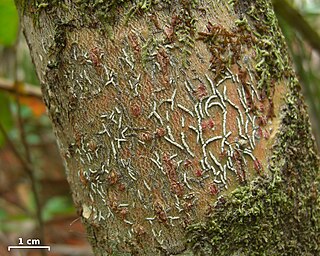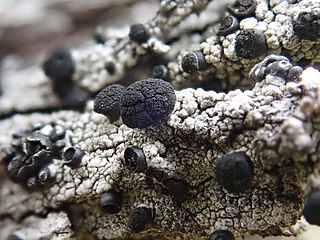
Dyplolabia is a genus of lichen-forming fungi in the family Graphidaceae. The genus was circumscribed by the Italian lichenologist Abramo Bartolommeo Massalongo in 1854, with Dyplolabia afzelii assigned as the type species.

Acarospora is a genus of mostly lichen-forming fungi in the family Acarosporaceae. Most species in the genus are crustose lichens that grow on rocks in open and arid places all over the world. They may look like a cobblestone road or cracked up old paint, and are commonly called cobblestone lichens or cracked lichens. They usually grow on rock, but some grow on soil (terricolous) or on other lichens. Some species in the genus are fungi that live as parasites on other lichens. Acarospora is a widely distributed genus, with about 128 species according to a 2008 estimate.

Acolium is a genus of lichenized fungi in the family Caliciaceae. The genus has a widespread distribution and contains six species. These lichens are found on bark and wood, occasionally on rocks, or growing on other lichens.

Roccella is a genus of 23 species of lichens in the family Roccellaceae. The genus was circumscribed by Swiss botanist Augustin Pyramus de Candolle in 1805, with Roccella fuciformis as the type species.
Sagiolechia is a genus of lichen-forming fungi in the family Sagiolechiaceae. The genus was circumscribed by lichenologist Abramo Bartolommeo Massalongo in 1854, who assigned Sagiolechia protuberans as the type species. The family Sagiolechiaceae was proposed in 2010 to contain Sagiolechia as the type genus, and genus Rhexophiale; molecular phylogenetic analysis showed that these two genera formed a distinct clade in the Ostropales.
Physma is a genus of cyanolichens in the family Pannariaceae. It has five species. The genus was circumscribed by Italian lichenologist Abramo Bartolommeo Massalongo in 1854, with Physma boryanum assigned as the type species.

Heppia is a genus of olive, brownish, gray, or blackish squamulose, crustose, or peltate like lichens. Heppia was once the type genus of the family Heppiaceae, but that family was folded into synonymy with Lichinaceae.

Sporastatia is a genus of crustose lichens in the family Sporastatiaceae. It has four species. Sporastatia lichens are long-lived species that grow on siliceous or weakly calcareous rocks in arctic and alpine locales.
Sporodictyon is a genus of crustose lichens in the family Verrucariaceae. It has 10 species. Most species grow on rocks, although some have been recorded overgrowing soil and mosses.

Ochrolechia upsaliensis is a species of crustose lichen in the family Ochrolechiaceae. Found in the Northern Hemisphere, it is commonly known as the tundra saucer lichen.

Solorina crocea, commonly known as the orange chocolate chip lichen, is a species of terricolous (ground-dwelling) and foliose (leafy) lichen in the family Peltigeraceae. The lichen, which was first formally described by Carl Linnaeus in 1753, has an arctic–alpine and circumpolar distribution and occurs in Asia, Europe, North America, and New Zealand. It generally grows on the bare ground in sandy soils, often in moist soil near snow patches or seepage areas. Although several forms and varieties of the lichen have been proposed in its history, these are not considered to have any independent taxonomic significance.
Acanthothecis collateralis is a rare endemic species of script lichen in the family Graphidaceae. Found in the Andaman Islands of India, it was formally described as a new species in 2007 by Urmila Makhija and Bharati Adawadkar. It is distinguished from other Acanthothecis species by its specific arrangement of ascomata and distinct chemical composition.
Fissurina capsulata is a species of corticolous (bark-dwelling) script lichen in the family Graphidaceae. Found in India, it was formally described as a new species in 2007 by Urmila Makhija and Bharati Adawadkar. The lichen is native to Kodaikanal, Tamil Nadu, where it was first identified near Daisy Bank in 1975.
Fissurina karnatakensis is a species of corticolous (bark-dwelling) script lichen in the family Graphidaceae. Found in India, it was formally described as a new species in 2007 by Urmila Makhija and Bharati Adawadkar. It grows on tree trunks in exposed conditions along roadsides within moist forests, particularly in Karnataka, a state known for its many endemic lichen species.
Fissurina khasiana is a species of corticolous (bark-dwelling) script lichen in the family Graphidaceae. It is found in India, specifically in the evergreen forests of Upper Shillong in the Khasi Hills; its species name is derived from the region where it was first collected. The lichen was formally described as a new species in 2007 by Urmila Makhija and Bharati Adawadkar.
Fissurina longiramea is a species of corticolous (bark-dwelling) script lichen in the family Graphidaceae. It is found in various locations across India, including the Andaman Islands, Karnataka, and the Nicobar Islands, where it grows in tropical rainforests. The lichen was formally described as a new species in 2007 by Urmila Makhija and Bharati Adawadkar.
Allographa grandis is a species of corticolous (bark-dwelling) lichen in the family Graphidaceae. Found in Cameroon, it is characterised its large ascomata and ascospores, and an inspersed hymenium.

Verrucaria viridula is a common and widely distributed species of saxicolous (rock-dwelling), crustose lichen in the family Verrucariaceae. Although it is a somewhat morphologically variable species, two persistent distinguishing characteristics are its relatively large perithecia, which are often curved into a beak, and its large ascospores.
Placomaronea kaernefeltii is a rare species of saxicolous (rock-dwelling) lichen in the family Candelariaceae. Found in South America, it was formally described as a new species in 2009 by lichenologists Martin Westberg, Patrik Frödén, and Mats Wedin. The type specimen was collected by the second author from Arica (Chile), between Socoroma and Putre, at an altitude of 3,750 m (12,300 ft), where it was found growing along cracks and pits on a siliceous boulder in a dry mountain slope. The lichen is only known to occur at its type locality, although the authors suggest a wider distribution is likely. The species epithet honours Swedish lichenologist Ingvar Kärnefelt.
Eilifdahlia sergeyana is a species of saxicolous (rock-dwelling), crustose lichen in the family Teloschistaceae. It is endemic to Kangaroo Island in South Australia. The lichen thallus has an uneven and scaly texture, forming patches up to 40 mm wide in dull greenish-grey or brownish-grey. Its fruiting bodies (apothecia) are orange to yellow, with a biatorine structure, and range from 0.5 to 1 mm wide. These apothecia have a matte surface and a cup-shaped margin containing golden-yellow crystals. The paraphyses within are slender and branched, and the asci contain ellipsoid spores.









